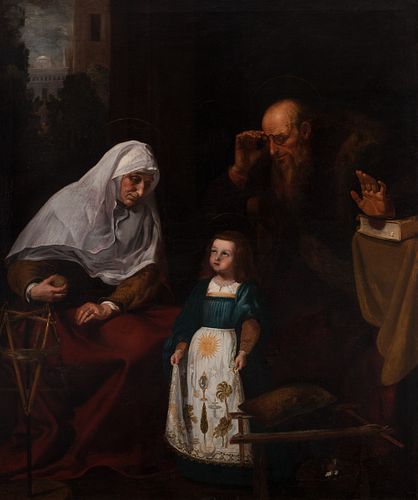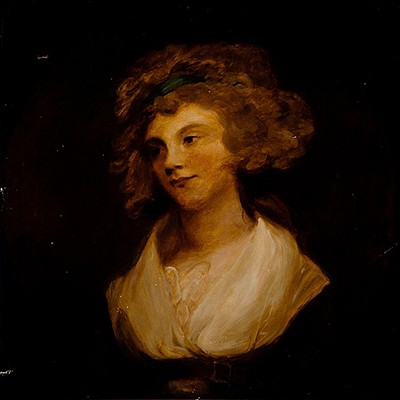FRANCISCO RIBALTA (Solsona, Lleida, 1565 - Valencia, 1628). "St. Joachim, St. Anne and the Child Virgin". Oil on canvas.
About Seller
Carrer Aragó 346
Barcelona
Spain
Setdart Subastas was born in 2004 and is currently the first online art auction in Spain with solidity, prestige and reliability guaranteed by our more than 60,000 users. Setdart has a young, dynamic and enterprising team ready to successfully manage the purchase and sale of art works through custom...Read more
Two ways to bid:
- Leave a max absentee bid and the platform will bid on your behalf up to your maximum bid during the live auction.
- Bid live during the auction and your bids will be submitted real-time to the auctioneer.
Bid Increments
| Price | Bid Increment |
|---|---|
| EUR€0 | EUR€10 |
| EUR€200 | EUR€25 |
| EUR€500 | EUR€50 |
| EUR€1,000 | EUR€100 |
| EUR€3,000 | EUR€200 |
| EUR€5,000 | EUR€500 |
| EUR€10,000 | EUR€1,000 |
| EUR€20,000 | EUR€2,000 |
| EUR€50,000 | EUR€5,000 |
About Auction
Nov 25, 2021
Setdart Auction House sofia@setdart.com
- Lot Description
FRANCISCO RIBALTA (Solsona, Lleida, 1565 - Valencia, 1628). "St. Joachim, St. Anne and the Child Virgin". Oil on canvas. Work expertized by the historian Don José Gómez Frechina. It presents restorations. Measurements: 140.5 x 117 cm; 159 x 136 cm (frame). During the baroque period numerous images of the Virgin proliferated, enriching its iconographic representations. It is not usual this type of scene where the Virgin is next to her two parents, since Mary's childhood is usually represented through her birth or her presentation in the temple. In this case the tenderness with which the author has represented the characters stands out, showing an intimate scene where some older parents place their attentive gazes on a little Mary. In spite of the childish and innocent appearance, the artist has defined the figure of the Virgin in the embroidered apron she wears; the crescent moon, the fountain etc...are Marian symbols typical of the Virgin. Following the words of a study carried out by the prestigious Nicolás Cortes gallery "in the church of San Juan del Hospital in Valencia there was a canvas with this same composition, according to Fernando Llorca in his book San Juan del Hospital de Valencia: una fundación del siglo XIII (Valencia, 1930). The fortune and acceptance of this painting is evident in the two 17th century copies preserved in the Museum of Fine Arts of Valencia (inv.3417 and 4083). Ribalta's original idea of capturing the Lauretan symbols on the Virgin's apron was later taken up by Jerónimo Jacinto de Espinosa (Cocentaina, 1600-Valencia, 1667). Catalan by origin, Ribalta began his training in El Escorial, within the mannerism that dominated court painting at that time. After beginning his career in Madrid, he moved to Valencia in 1599, probably encouraged by the patronage of the patriarch Archbishop Juan de Ribera. There he produced his first known works, the altarpieces for the church of Algemesí, which denote a style somewhere between the mannerism of the Escorial style and naturalism. During these first years of the 17th century he carried out several commissions for the archbishop, whose death in 1611 marked a certain stylistic turn in Ribalta's work. His language takes an intimate and profound slant, very much in keeping with the more pious mood of the Counter-Reformation, inspired by the solemn gravity of certain models of Sebastiano del Piombo that he knew in Valencia itself. Ribalta knew how to combine these influences with a naturalistic and direct language for which he was especially gifted. His chromatism also became more restrained and sober, and his figures lost in gesticulation to deepen in expressive intensity. From the second decade of the century his disciple Vicente Castelló and his son Juan Ribalta worked with him, forming a solid and prolific artistic team, in which sometimes it is not easy to distinguish their individualities. Around 1618 Ribalta fell ill, and this was the beginning of his last stage, the most mature of his production. He painted fewer works, but his style became more intense and emotional, entering into a deep naturalism of moving force, as seen in his great painting "Embrace of St. Francis to the Crucified", painted for the Capuchins of Valencia around 1622. Six years later Francisco Ribalta died, and a few months later also his son Juan, leaving traced in the Valencian painting guidelines that would last for a long time, conditioning the development of the Baroque style. In fact Ribalta was, together with Velázquez and Ribera, one of the main founders of the naturalistic language in Spain. Works by Francisco Ribalta can be seen in the Prado Museum, the National Gallery of London, the Museum of Fine Arts of Valencia, the Hermitage of St. Petersburg, the Louvre, the National Museum of Art of Catalonia, the Chi-Mei of Taiwan and the J. Paul Getty Museum of Los Angeles, among other art galleries.
Dimensions:
INV Number:
140.5 x 117 cm; 159 x 136 cm (frame).
35272701 - Shipping Info
-
In-house shipping available. Please inquire at admin@setdart.com.
-
- Buyer's Premium



 EUR
EUR CAD
CAD AUD
AUD GBP
GBP MXN
MXN HKD
HKD CNY
CNY MYR
MYR SEK
SEK SGD
SGD CHF
CHF THB
THB

















